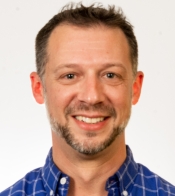10,000-year-old house reveals history of farmland ownership in neolithic Middle East

Remains of the structure at al-Khayran, with the cobblestone and flagstone surfaces visible in the foreground and the walls visible in the background. Photo courtesy of Matthew Kroot
On the edge of the Jordanian plateau, overlooking the Dead Sea basin, there is an archaeological site that is nearly 10,000 years old. That is more than 5,000 years older than the oldest pyramid in Egypt, and about 1,700 years removed from the end of the last ice age.
The site, al-Khayran, was excavated by Arizona State University archaeologist Matthew Kroot and contains some of the earliest physical evidence proving the existence of private farmland ownership.
Kroot details his findings in the article “Accommodating agriculture at al-Khayran: Economic relations and settlement practices in the earliest agricultural communities of the southern Levant,” recently published in the Journal of Anthropological Archaeology.
“This happens during a period called the neolithic, when people started farming for the first time instead of getting wild food through gathering, fishing, hunting and the like,” said Kroot, an assistant professor in ASU's School of Human Evolution and Social Change. “It has long been thought that the neolithic would be the first time where people started owning land, but we never had direct evidence of it.”
Kroot was the project director of a team at the site in Jordan from 2007 to 2010. One day, seven and a half months into their work, a wall was found. Khaled Tarawneh, the team’s Department of Antiquities of Jordan monitor, called to Kroot: “Matt! There’s a wall!”
Up until this point, the team did a lot of test excavations but only found stone tools and a dumping ground of plaster.
“I thought, you know it’s rocky here; there might be three stones in a row accidentally. I'm not sure I believe this,” Kroot said. “And then you could just see the whole house completely. There were walls, a patio in the front, a cobblestone surface.”
Kroot said the patio was astounding; it was made of carved flagstones similar to what you would find today at a home improvement store. The house walls were thick and its floors were made with plaster. This was the only structure found at al-Khayran.
Based on how the house was made and the types of stone tools that were found, and by using radiocarbon dating on a piece of burnt wood and burnt animal bone, Kroot was able to date the site to a small, subperiod of the neolithic called the middle pre-pottery neolithic B (MPPNB).
“Almost all previous research into those communities in the MPPNB that farmed has focused on villages," he said. “There are a handful of other types of sites, such as cemeteries or caves used in rituals or hunting camps or mining sites. However, al-Khayran is the first agricultural field house.”
Based on the size and architecture of the field house, Kroot was able to determine it was owned by one family, not a community, and that it was seasonally used. Analysis of the plants at the site showed that people living during this time period were growing wheat or barley.
How does an archaeologist determine if a 10,000-year-old stone house was used seasonally? Kroot explained.
The tools inside the structure were stored very intentionally, probably kept in containers that rotted away. When the farmers came back seasonally, all the tools would be ready to use and easy to locate.
Scientists also used stratigraphy, analyzing layers of rocks and dirt. At al-Khayran, Kroot was able to determine there was a dry season and a wet season, and the field house collapsed in the wet seasons and then was rebuilt in the dry seasons.
“So the house falls over and there are all these pebbles and rocks and dirt,” he said. “And then there are these thin layers of waterborne silt sediment.”
Kroot says using archaeology and studying rocks to learn about human culture and the development of private property and even exploitation is complex.
“We have virtually nobody killing each other in the neolithic period at all. Why?” Kroot asks. “There was seemingly no war, minimal murder. What were people doing that made life this way?
“You have to answer these important questions for humanity by studying rocks. And you have to look at these pieces and reconstruct them to answer important questions about inequality, equality, power and social harmonies.”
Kroot plans to publish more articles about his work and findings at al-Khayran; however, the excavation phase of this research is complete.
Currently, Kroot conducts fieldwork in Arizona and Senegal, in West Africa.
More University news

ASU earns 'Gold' in inaugural Times Higher Education Online Learning Ranking
Arizona State University continues to set the standard in online learning, having earned a Gold rating in the inaugural Times Higher Education Online Learning Ranking 2024. This recognition…
2024 President's Awards honor ASU projects for real-world impact
Ten Arizona State University programs were honored for their real-world solutions during the annual President’s Awards ceremony held on Dec. 6.The awards formally recognize successful solutions in…

ASU celebrates Paul C. Helmick Center renaming
When Mary Jo Helmick cut the ribbon at the front doors of the Paul C. Helmick Center at Arizona State University, more than 100 education leaders, faculty, staff, family and friends cheered.“This has…

